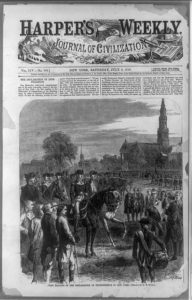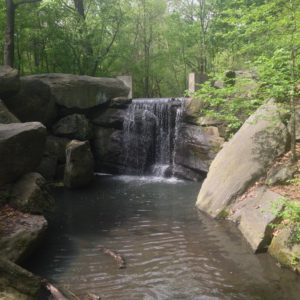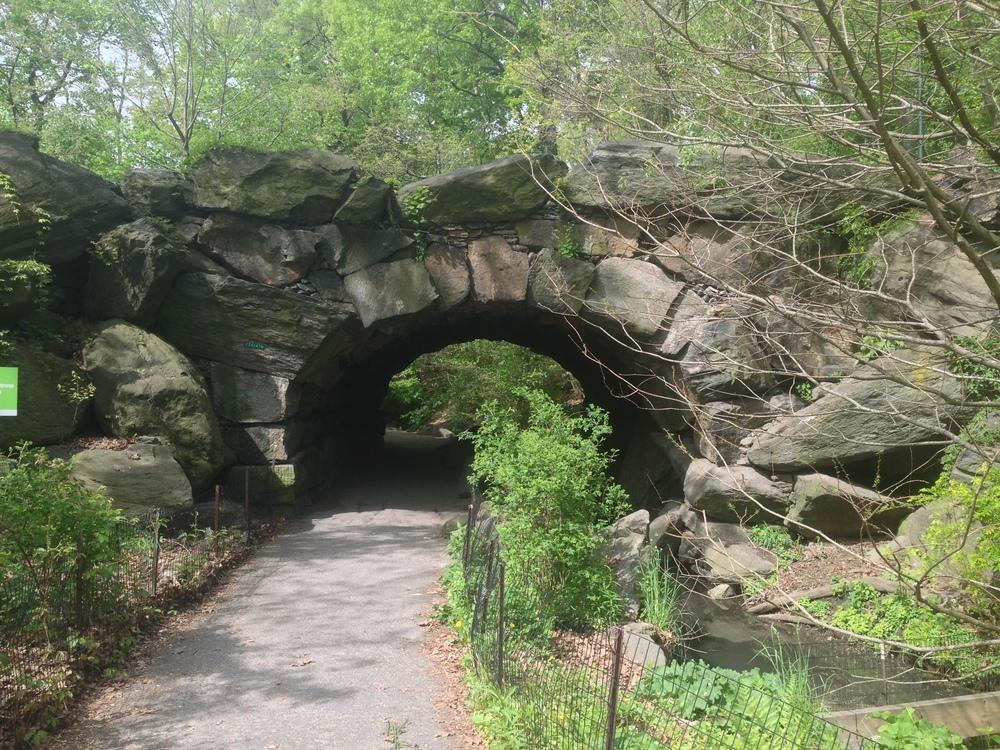by John Semlak | Jul 9, 2016 | #NYCHistory, #NYCParks, #ONTHISDAY

Illustration of George Washington reading the Declaration of Independence in New York on July 9th 1776. St. Paul’s Chapel, which still stands, is in the background right. The image by A.R. Waud appeared on July 9th, 1870 in Harper’s Weekly.
On July 9th 1776, George Washington read aloud the Declaration of Independence which had been read first 5 days earlier in Philadelphia. He read it in front of his troops in the area then called the Commons, where today’s City Hall Park is. The spot is commemorated with an inscription on the pavement inside City Hall Park.
 Inscription on the pavement in City Hall Park commemorating Washington’s reading of the Declaration of Independence, unfortunately faded badly.
Inscription on the pavement in City Hall Park commemorating Washington’s reading of the Declaration of Independence, unfortunately faded badly.
Inspired by Washington’s reading of the Declaration, soldiers and patriots marched down to Bowling Green Park and tore down a statue to King George III, which had been erected only six years earlier to try to improve support for the monarchy in the city. The statue was melted down and used to make bullets used by the Continental Army. Today, a fence surrounds the park what was originally installed to protect the
statue of George. It had crowns on its lampposts which were sawed off by the patriots.
 Painting by Johanes Adam Simon Oertel depicting the pulling down of the statue of King George the III at Bowling Green Park. This painting hangs at the New-York Historical Society.
Painting by Johanes Adam Simon Oertel depicting the pulling down of the statue of King George the III at Bowling Green Park. This painting hangs at the New-York Historical Society.
New York City was at the time Rebel territory but would be abandoned by Washington later that year and held by the British for the remainder of the war. Washington would return to New York at the end of the war to officially liberate the city on November 25th, 1783, when the final British troops evacuated the city.
by John Semlak | Jun 13, 2016 | #NYCParks
 North Woods in Autumn
North Woods in Autumn
Central Park is justifiably New York City’s most popular tourist attraction, visited by 42 million people annually. Most tourists spend the majority of their time in the southern portion of the park, around iconic sites like the Bethesda Fountain, the Bow Bridge, and Strawberry Fields. A few venture a little further north to Belvedere Castle or the Conservatory Pond (and the Alice and Wonderland Statue. But many visitors–tourists and New Yorkers alike, do not visit the far northern portions of the park. And that is a great shame. Full of natural wonders and historic landmarks, the area roughly called the North Woods is perhaps the most enjoyable part of the park.

A waterfall near the Huddlestone Arch.
 The Loch in the North Woods. The North Woods was intended from the beginning to have a rugged appearance.
The Loch in the North Woods. The North Woods was intended from the beginning to have a rugged appearance.
The North Woods lies roughly north of 101st street in the western and central parts of the park, West of the Harlem Meer. Much of that portion of the park was acquired after the rest of the park was initially developed, and was intended to be more rugged. Along with Hallett’s Wildlife Sanctuary and the Ramble, it is one of three natural woodlands in the park and teeming with wildlife. Far less crowded with people than other parts of the park, the North Woods has the greatest variety of wild animals in Central Park.
 The Huddlestone Arch
The Huddlestone Arch
Within the North Woods is the Ravine, an artificial river called the Loch with several picturesque waterfalls. The Ravine contains three remarkable and distinct bridges. One the west end is the Glen Span Arch, a stone bridge built in 1865. In the middle is the small wooden footbridge called the Ravine Rustic Bridge. At the Northeastern end of the Ravine is the Huddlestone Arch, and 1866 bridge designed by Calvert Vaux made from 100 tons of boulders held together by gravity.
 The Rustic Ravine Bridge over the Loch
The Rustic Ravine Bridge over the Loch  the Harlem Meer and part of today’s version of McGowan’s Pass
the Harlem Meer and part of today’s version of McGowan’s Pass
Around the the edges of the North Woods are the remains of several fortifications that date back to before Central Park was created in the mid-1800s. The most well preserved is the Blockhouse, a fort built on a hill for the War of 1812. It is the oldest building in Central Park. To the East is Fort Clinton, The fort built in 1814 no longer remains, but the spot is marked by two 18th century cannons recovered from a British warship the Hussar. Nearby are Nutter’s Battery and Fort Fish, both sites for former early 19th-century fortifications. These forts guarded the entrance into Manhattan by McGowan’s Pass, a path that wound through the then rugged terrain into lower Manhattan. .
 The Blockhouse. Built in 1814, it is the oldest building in Central Park
The Blockhouse. Built in 1814, it is the oldest building in Central Park
Finally, a visit to the North Woods can be finished with a stunning contrast–the Conservatory Gardens, a highly manicured formal garden on the East side of Central Park’s northern portion. A far cry from the rugged natural beauty of the North Woods, the Conservatory Garden features beautiful flowerbeds, lovely statues, and wonderful fountains. It is popular with couples on a walk and a spot for weddings. Another great finish of a North Woods tour is the Harlem Meer Concession Stand just north of the Conservatory Garden, now occupied by a Moaz falafel stand.
 The Conservatory Garden
The Conservatory Garden

 Inscription on the pavement in City Hall Park commemorating Washington’s reading of the Declaration of Independence, unfortunately faded badly.
Inscription on the pavement in City Hall Park commemorating Washington’s reading of the Declaration of Independence, unfortunately faded badly. Painting by Johanes Adam Simon Oertel depicting the pulling down of the statue of King George the III at Bowling Green Park. This painting hangs at the New-York Historical Society.
Painting by Johanes Adam Simon Oertel depicting the pulling down of the statue of King George the III at Bowling Green Park. This painting hangs at the New-York Historical Society. North Woods in Autumn
North Woods in Autumn
 The Loch in the North Woods. The North Woods was intended from the beginning to have a rugged appearance.
The Loch in the North Woods. The North Woods was intended from the beginning to have a rugged appearance. The Huddlestone Arch
The Huddlestone Arch The Rustic Ravine Bridge over the Loch
The Rustic Ravine Bridge over the Loch  the Harlem Meer and part of today’s version of McGowan’s Pass
the Harlem Meer and part of today’s version of McGowan’s Pass The Blockhouse. Built in 1814, it is the oldest building in Central Park
The Blockhouse. Built in 1814, it is the oldest building in Central Park The Conservatory Garden
The Conservatory Garden